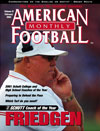AMERICAN FOOTBALL MONTHLY THE #1 RESOURCE FOR FOOTBALL COACHES
Article CategoriesAFM Magazine
|
Troubleshooting in Man Coverage techniques.Wabash College, Defensive Backs Coach© More from this issue There is one intangible in today’s aggressive multiple front multiple blitz defenses. No matter how well your front seven and safeties are stopping the run, the one factor in truly shutting down an offense is good man coverage. To coach good man coverage, a coach must understand what the receiver is trying to accomplish versus different man-coverage techniques, and then coach his players to play the different ways a receiver will attack a specific technique. Receivers and Quarterbacks both determine routes according to what is shown both pre-snap and post-snap. Pre-Snap= Receivers will try to determine if the corner is playing:
|
|
|||||||
| HOME |
MAGAZINE |
SUBSCRIBE | ONLINE COLUMNISTS | COACHING VIDEOS |
Copyright 2025, AmericanFootballMonthly.com
All Rights Reserved





